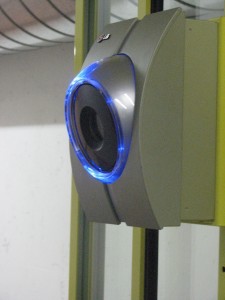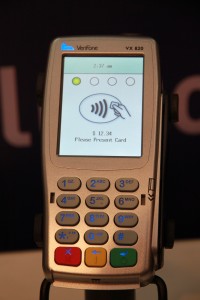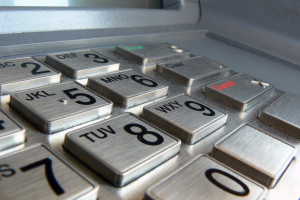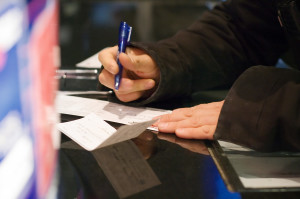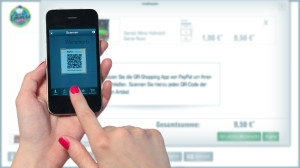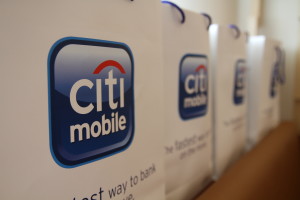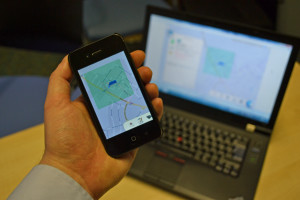October 21st, 2013 by Elma Jane
UL’s (Underwriter Laboratories) latest contribution to the future of payments has been accomplished through its three years of work with National Security, a French biometrics company that has created a commercially viable biometric technology solution for the point of sale.
The move positions UL and National Security at the forefront of an industry that is expected to expand by 140 percent to reach $12 billion in revenue over the next five years, potentially transforming online, mobile and in-store commerce by increasing the speed of transactions in the process.
Still, arguments can be made that biometric use at the point of sale will remain limited. Why does UL believe the market is right for biometrics, and how did it successfully ensure biometric payments will be ready for all parts of the payment process?
Why The Time Is Now For Biometrics
Consumer concerns regarding identity theft and violence are on the rise, and the solution according to many is a viable biometrics payment solution. Reports show that there is already strong demand in the U.S. and Asian markets for such products, and major research outlets have put their support behind the technology.
UL’s case study elaborates on the benefits illustrating how biometric data has been developed to be harder for hackers to infiltrate and compliant with EMV security standards.
Developing The Technology
UL’s work to ensure biometrics will remove friction at the POS has been extensive. For example, its latest case study profiles how UL developed the underlying technology to overcome challenges and work in harmony with wireless technologies such as bluetooth and Wi-Fi. Further, it explains how UL assessed the human health impact of National Security’s biometric solutions.
Posted in Credit card Processing, Electronic Payments, EMV EuroPay MasterCard Visa, Mobile Point of Sale, Near Field Communication, Point of Sale Tagged with: biometric, bluetooth, commerce, data, developing, EMV, future, hackers, identity theft, impact, in-store, mobile, online, payment process, payments, point of sale, POS, process, security standards, solution, speed, transactions, viable, Wi-Fi, wireless
October 17th, 2013 by Elma Jane
VeriFone and National Payment Card Association (NPCA) debuted a mobile payment and rewards solution that enables convenience store and petroleum retailers to provide customers with smartphone-based payment options at the pump.
Utilizing VeriFone’s Smart Fuel Controller and NPCA’s mobile payment solution, c-store and gas station operators with VeriFone payment acceptance systems can quickly implement a fixed low-cost mobile payment and rewards program built on existing infrastructure used for merchant branded debit cards.
Consumers are increasingly drawn to rewards-based fuel purchase programs and they expect to be able to use their mobile phone to complete transactions at the pump. NPCA and VeriFone are showing how easy it is for CSPs to offer mobile payment and reward options to customers that increase loyalty and sales.
VeriFone Smart Fuel solutions make it easy for CSPs to offer forecourt pump POS payment without incurring the cost of installing new dispensers. The Smart Fuel Controller combines pump and pay-point support into a single unit, simplifying installation and maintenance, and eliminating the need for third-party interface devices to integrate pay-point management with in-store POS systems.
Merchants can develop their own mobile app, or apply their brand to a mobile app supplied by NPCA, to enable customers to pay for purchases and receive loyalty incentives using their smartphones.
Consumers today would rather utilize the capabilities of their smartphones versus pulling out their wallets. Using this solution, retailers can easily and cost-effectively create mobile loyalty programs that attract and reward high-value customers – without having to replace their existing payment infrastructure.
NPCA’s debit-based payment programs provide retailers with the ability to drive customer loyalty and reduce the cost of payments. Fuel discounts are funded from interchange savings that retailers would otherwise pay to banks. Payment processing is done by NPCA using the automated clearing house (ACH) system to clear debits to cardholder checking accounts and net settle with retailers each day. The company holds five patents related to the processing and methods for ACH-based decoupled debit and mobile payments.
Come November VeriFone and NPCA mobile payments solution will be available for beta testing.
Posted in Electronic Payments, Mobile Payments, Point of Sale, Smartphone, Visa MasterCard American Express Tagged with: acceptance, ach, app, apply, cardholder, consumers, cost, debit cards, devices, infrastructure, interchange, interface, loyalty, merchant, mobile, pay-point, payment, payments, phone, POS, Processing, rewards, sales, smart, Smartphones, solution, transactions, verifone, wallets
October 15th, 2013 by Elma Jane
Banking and payments technology provider FIS and City National Bank, a private and business bank, have partnered to pilot FIS’s Cardless Cash Access at City National ATMs in Los Angeles, New York City and San Francisco. The solution lets consumers stage an ATM transaction from their mobile devices.
City National plans to introduce the emerging technology to clients in its three largest markets early next year, according to an FIS announcement, continuing FIS’ rollout of the solution at banks and ATMs in key U.S. locations.
FIS said Cardless Cash Access securely authenticates a user on his or her smartphone. The consumer then uses the phone to select the account and amount of the withdrawal. At the ATM, the consumer scans a QR code on the ATM screen and, within seconds, the cash is dispensed and an e-receipt is sent to the phone.
Consumers continue to look for innovative new ways to engage with their financial institutions via mobile devices, FIS Mobile, said in the release. At the same time, they demand additional security to keep their information safe. Information from Cardless Cash Access is maintained in the cloud, so card data cannot be accessed if the consumer’s phone is lost or stolen – making this a faster, safer, more secure way to make a withdrawal.”
To decrease fraud, FIS said, security within Cardless Cash Access is provided through the app’s authentication and registration of a user’s smartphone, which the company said eliminates card skimming risk and fraud incidents for banks and their clients.
With the proliferation of debit and access to cash at the point of sale, financial institutions are looking for ways to expand the utility of the ATM,” Senior vice president and head of product strategies, Vince Hruska, City National Bank, said in the release. “Cardless Cash Access not only provides a secure and easy way to obtain cash from an ATM, but introduces to the client a new way of looking at ATM use.
Posted in Financial Services Tagged with: account, amount, atm, authenticates, banking, banks, card, cardless, cash, data, e-receipt, emerging, financial, Mobile Devices, national, payments, QR code, securely, Security, Skimming, smartphone, transaction
October 15th, 2013 by Elma Jane
What is an electronic check?
Electronic Check also known as Echeck – is an electronic version of a Paper Check. Electronic Checks allow merchants to convert paper check payments made by customers to electronic payments that are processed through the (ACH) Automated Clearing House Network. It’s a fast, efficient, and secure way to process check payments.
Because of the many benefits and increased security methods that electronic checks offer, this method of payment is quickly growing in popularity. In 2007, electronic check conversion increased by 30%, with more than 3.1 billion paper checks converted to echecks through in-store transactions. Familiarizing yourself with how electronic checks work, the benefits and security features they offer, and how you can get started with electronic check conversion will save you time and money and help you provide greater protection for your business and your customers.
How it works:
Electronic check conversion is a simple method of processing payments, and the changes to how you do business are minimal. One of this method’s greatest advantages is that you can electronically submit checks instead of having to physically take them to the bank, saving you time and increasing employee efficiency.
When you receive a paper check payment from your customer, you will run the check through an electronic scanner system supplied by your merchant service provider like National Transaction Corporation (NTC). This virtual terminal captures the customer’s banking information and payment amount written on the check. The information is transferred electronically via the Federal Reserve Bank’s ACH Network, which takes the funds from your customer’s account and deposits them to yours.
Once the echeck has been processed and approved, the virtual terminal will instantly print a receipt for the customer to sign and keep. Employees should mark the paper check as “void” and return it to the customer. Your merchant transactions will be available online for viewing with customized detailed reporting, which may vary in features depending on the merchant service provider you choose.
Using electronic check conversion to process your customers’ payments holds many benefits over paper checks:
Benefits:
1. Received Funds Sooner. Businesses that use electronic check conversion have funds deposited almost twice as fast as those using the traditional check processing method, with billing companies often receiving payments within one day.
2. Reduced Fraud and Fewer Errors. Echecks are processed using an automated system, which cuts down the number of people who must handle the check, reducing the potential for error and fraud. Merchant service providers (NTC) also maintain, monitor, and check files against negative account databases that store information about individuals or companies that have past records of fraud to help decrease fraudulent activity.
3. Reduced Processing Costs. In general, the cost to process an echeck is substantially less than that of paper check processing or credit card transactions. Echecks require less manpower to process and eliminate incidental costs such as deposit and transaction fees that accompany paper checks. With Echecks, you can save up to 60% in processing fees.
4. Sales Increase. If your business didn’t accept paper checks in the past, you can expand the payment options available to your customers and increase sales by offering echecks. If you are converting from accepting paper checks to echecks, you can still expand your customer base by being able to accept international and
out-of-state checks without the worry of fraud. Echecks require account validation and customer authentication processes that identify bad checks within seconds.
5. Safe, Simple and Smart. Electronic check conversion is easy to set up and relies on the ACH Network for processing, the same reliable and trusted funds transfer system that handles Direct Deposit and Direct Payment. Plus, echecks are a smart choice for the environment, helping to reduce more than 67.4 million gallons of fuel used and 3.6 million tons of greenhouse gas emissions created by transporting paper checks.
Increase security with electronic checks – Electronic check conversion leverages the latest information protection features such as encryption and message authentication. Because of this, many retail merchants, merchant service providers, and financial institutions consider it to be one of the most secure payment methods in the electronic payment processing industry.
Authentication – Merchants must verify that the person providing the checking account information has the authority to use that checking account. There are a number of authentication services and products available to merchants, including:
Digital Signatures or Digital Certificates are a way of Encrypting information that gives the receiver a more reliable indication that the information was sent by the claimed sender. They are used by programs on the Internet to confirm the identity of a customer to concerned third parties, serving a similar purpose as a handwritten signature. Digital Signatures cannot be easily tampered with or imitated and are easily transportable, thereby making them a reliable method for verifying identity when implemented correctly. Digital Signatures are often used to implement Electronic Signatures, a broader term that refers to any Electronic Data that carries the intent of a signature.
Duplicate Detection and prevention is another way to reduce fraudulent activities. Financial institutions have software and operational controls in place to prevent duplication of the scanned electronic representations of customer checks.
Encryption The ACH Network automatically encrypts messages using 128-bit encryption and a secure sockets layer (SSL).
Public Key Cryptography is an Encryption/Decryption Security Method that uses one key to Encrypt a sent message and another to Decrypt it. With Electronic Check Conversion, the Private Key is a secret mathematical calculation used to create the digital signature on the Echeck, and the Public Key is the corresponding key given to anyone who needs to verify that the sender signed the echeck and that the electronic transfer has not been tampered with. Public Key Cryptography is another way to ensure authenticity of the Electronic Transfer of Funds.
What is the (ACH) Automated Clearing House Network?
The Automated Clearing House (ACH) Network is a funds distribution system that moves funds electronically from one entity to another. This highly reliable and efficient nationwide electronic network is governed by the rules established by the National Automated Clearing House Association (NACHA) and the Federal Reserve (Fed). The ACH payment system also handles debit card transactions; direct deposits of payroll, Social Security, and other government benefits; direct debit payments; and business-to-business payments.
How to get started with Echeck:
Useful advice to help make the implementation of electronic check conversion at your business run smoothly:
Choose a processing company that is well established in the market. While a competitive pricing package may also be of importance, having a processor that is reliable with a good reputation is essential.
Look for a processor that enables you to easily align your current business processes with your new electronic processing system. Ensure that you can easily export customer data and smoothly integrate the electronic payment processing system with your business management software.
Notify your customers that your business will begin using electronic check conversion to process payments. Federal rules require you to post a notification about this change in practice as well as to give your customers a takeaway copy of the notification. You must also provide customers a telephone number to request more information about electronic check conversion.
Posted in Electronic Check Services, Electronic Payments, Financial Services Tagged with: ach, authentication, automated clearing house, bank, check, checks, conversion, deposited, digital, echeck, electronic, electronically, encryption, fees, in-store, market, merchant, merchant service provider, money, online, payments, process, Processing, reporting, scanner, Security, signature, submit, terminal, transactions, virtual
October 10th, 2013 by Elma Jane
Merchant Cash Advance was originally structured as a lump sum payment to a business in exchange for an agreed upon percentage of future credit card and/or debit card sales.
Notion Merchant Cash Advance companies provide funds to businesses in exchange for a percentage of the businesses daily credit card income, directly from the processor that clears and settles the credit card payment. A company’s remittances are drawn from customers’ debit- and credit-card purchases on a daily basis until the obligation has been met. Most providers form partnerships with card-payment processors and take payments directly from a business owner’s card-swipe terminal.These Merchant Cash Advances are not loans – they are a sale of a portion of future credit and/or debit card sales. Therefore merchant cash advance companies claim that they are not bound by state usury laws which limit lenders from charging excessive interest rates. This technicality allows them to operate in a largely unregulated market and charge much higher interest rates than banks. This structure has some advantages over the structure of a conventional loan. Most importantly, payments to the merchant cash advance company fluctuate directly with the merchant’s sales volumes, giving the merchant greater flexibility with which to manage their cash flow, particularly during a slow season. Advances are processed quicker than a typical loan, giving borrowers quicker access to capital. Also, because MCA providers typically give more weight to the underlying performance of a business than the owner’s personal credit scores, Merchant Cash Advances offer an alternative to businesses who may not qualify for a conventional loan.
Usage Merchant cash advances are most often used by retail businesses that do not qualify for regular bank loans, and are generally more expensive than bank loans. Competition and innovation led to downward pressure on rates and terms are now more closely correlated with an applicant’s FICO score.
Generally there are three different types of repayment methods for the business.
1. ACH (Automated Clearing House) Withholding: When structured as a sale, the finance company receives the credit card processing information and deducts its portion directly from the business’s checking account via ACH. When structured as a loan, the finance company debits a fixed amount daily regardless of business sales activity.
2. Lock Box or Trust Bank Account Withholding: All of the business’s credit card sales are deposited into bank account controlled by the finance company and then the agreed upon portion is forwarded onto the business via ACH (Automated Clearing House), EFT ( Electronic Funds Transfer) or wire. This is the least preferred method since it results in a one-day delay in the business receiving the proceeds of their credit card sales.
3. Split Withholding: When the credit card processing company automatically splits the credit card sales between the business and the finance company per the agreed portion (generally 10% to 22%). This is generally the most common and preferred method of collecting funds for both the clients and finance companies since it is seamless.
Opting for a merchant cash advance is a decision made by small business owners every day of the week across this country. If you’re having a hard time establishing a business line of credit or getting approved for a business loan, a merchant cash advance may very well be the best option available to you to help you finance your business.
Here are reasons why a business cash advance makes sense.
A. Can take out more advances as advance is repaid
Most business loans will not be extended as you pay off your balance, but with a merchant cash advance, you can get more money as you pay off your advance.
B. Even with less-than-perfect credit, you can be approved
No worries about being approved if you have less-than-perfect credit, a high credit score is not a major factor in whether you are can receive business funding from a cash advance.
C. Flexible repayment terms – repayment is based on sales volume, not a flat rate
Some businesses can run into financial hardships with traditional business loans that require flat-rate monthly payments, but with merchant cash advances your monthly payments are dependent on your sales volume. This means that if you have a slow month, you pay back less.
D. Frees up time because of the simple application/approval process
The application and waiting process for a business loan or even a business line of credit can be outstanding –sometimes you have to wait 30 days just to receive notice of approval from your application, add the wait time to the back and forth calls, document signing, etc – and it can be an arduous process. However, by choosing a merchant cash advance, you can quickly qualify online or by phone.
E. Gives you more money in your pocket to improve cash flow
Cash advances can give you the opportunity to receive more money than you would be able to borrow from a bank.
F. Gives you money right away
With a merchant cash advance you literally can have your cash in as little as 72 hours from your applications approval – and most businesses get their funding in less than a week. Now that’s a simple process
G. New business friendly
Many small business loans require that you have a well-established business (2 years or more) to even consider you for business funding. With a cash advance, you can receive funding even if your company is newly in business.
H. No personal liability for repayment of the cash advance
Much unlike with business lines of credit and small business loans, you are not personally responsible for repayment of the advancement.
I. Non-restrictive usage on what you use the funding for
Too many times business owners are restricted by what they can do with their business loans. But, because a cash advance is designed to help you improve your cash flow, you can use your new funds wherever your business needs them.
J. Qualification is easier than with traditional business loans
Banks have a lot of stipulations for businesses that they loan money to or extend credit lines – cash advances have minimal qualifications and high approval rates.
Posted in Best Practices for Merchants, Merchant Cash Advance, Merchant Services Account Tagged with: ach, automated clearing house, bank, business, businesses, capital, cash advance, credit-card, eff, electronic, excessive, flat-rate, funds, loan, loans, merchant, money, online, pay, payments, Processing, purchases, Rates, signing, transfer
September 30th, 2013 by Elma Jane
Future of Marketing Lies in Mobile Payments…Why?
Marketing and payments might seem like strange bedfellows to the average retailer, but in fact, they are converging rapidly to bring more value to consumers and merchants alike. Here are 10 reasons why the future of marketing is inextricably linked to payments innovation:
1. Cross-Platform Acceptance
Better yet, these targeted offers can be acquired and redeemed through different mediums…online, offline and mobile…and utilized interchangeably. This makes life easier on the consumer and thus makes them more likely to engage with new loyalty and rewards programs. Moreover, as the Internet and mobile solutions continue to merge, the digital “wallets” that many of us use online today (think PayPal) are, logically, moving to our phones. When these payment and marketing applications are accessible from the same device, customers can seamlessly receive pertinent offers and pay for goods at the same time in the same place. Other apps will give consumers the ability to shop in one medium and buy in another, simplifying omni-channel marketing to affect commerce across all channels. This kind of convenience and value is a win for both customer and merchant.
2. Loyalty and Rewards get Simpler
The reality is that it’s much easier to issue and redeem loyalty rewards, gift cards and discounts when they are integrated into the POS experience and don’t require customers or merchants to alter the existing in-store purchase or checkout stream. You can see these simplified applications already in practice at chains like Starbucks, as well as independent merchants that use systems like LevelUp.
3. Merchant adoption
The payment technologies that succeed will be the ones that are ultimately adopted by merchants, which in turn will lead to consumer usage. Key technologies that will likely facilitate widespread adoption of mobile payments…either proactively because merchants want to see what they can offer them, or passively as they upgrade devices…include:
EMV (chip and pin), which will force merchants to update their POS systems, likely catalyzing them to update all points of interaction.
NFC – Cloud Computing – Geofencing – QR Codes and even Basic Bar Codes
4. More Value for Consumers
And for consumers, the convergence of payments and marketing should deliver highly valuable deals, offers, comparisons information and more, ultimately providing drastic improvement of the buying and shopping experience.
5. More Value for Merchants
So what does this value look like? For merchants, the convergence of payments and marketing should bring in new customers, increase sales from existing customers, and provide more customer data. It should also create a more streamlined multi-channel experience so consumers have little barrier to adoption.
6. No Single Technology will Win
These new technologies introduce an interesting question: What should merchants do to prepare for this brave new world where payments and marketing collide? For one, merchants should avoid betting on any one technology. In fact, the POS needs to morph into something a little more complex, becoming instead a POI, where a broad variety of payment types, loyalty programs, coupons and more can be redeemed. Merchants should be in a position to choose what types of payment they want to accept and in what medium, and not be limited to fixed payment tenders.
When the convergence of marketing and payments will happen
The increasing adoption of mobile payments by merchants and consumers, when combined with new POS environments, will jump-start the convergence of marketing and payments. However, we’re still in the early stages.
Mobile commerce technologies are widespread but still working to gain traction from consumers en masse. Additionally, merchants haven’t yet felt the need to upgrade their POS systems to accept mobile payments
However, the October 2015 EMV Liability Shift, a date set by Visa and MasterCard for certain charge-back liabilities to fall to the merchant unless they have upgraded to EMV-capable POS systems, is likely to push merchants to upgrade their systems.
Once merchants begin to upgrade these POS systems, the smart ones will take the opportunity to add more features and functionality to the systems, including the ability to accept payment…and marketing-driven solutions from mobile handsets. That’s when we’ll see the value of two-way communication between merchants and consumers dramatically change the shopping experience and bring payments into the marketing mix.
7. Smartphone Adoption is Speeding Up
Consumers’ mobile phones are already equipped to deliver highly valuable offers, and adoption is increasing at a rapid pace. Smartphones bring with them new app technologies that include not only mobile payments but also loyalty and rewards programs that are designed to drive preference for stores, good and services.
8. Targeted Offers and Single-Use Applications
Of course, these solutions are still in their infancy. Elegant single-use applications, such as mobile wallets and gift cards, will soon grow to provide highly targeted offers that take into account everything from shopping preferences to location, providing incentives as a customer walks the aisle of a store. Just about every player in the payments ecosystem is thinking about these new commerce technologies. The winners will be those that demonstrate clear value for both the merchants and customers.
9. The “POS” is now a “POI”
A point-of-sale (POS) solution used to be a place where goods were purchased and money traded hands. Usually, this took the form of a cash register or credit card machine. Though these still exist, a wave of new value-added marketing services, such as targeted offers, discounts and highly valuable loyalty applications, have led to the transformation of the POS into a point-of-interaction (POI), a place where consumers and merchants meet to exchange value for value.
10. Two-way communication
When embedded in smartphones, new technologies…like near-field communication (NFC), QR codes, geofencing and cloud authentication solutions…allow for two-way communication between the consumer and the POS solution, enabling merchants to deliver coupons and offers directly to customers’ mobile phones through targeted integrated programs.
Posted in Digital Wallet Privacy, e-commerce & m-commerce, Mobile Payments, Mobile Point of Sale, Smartphone Tagged with: bar codes, cloud, device, EMV, handsets, innovation, loyalty, marketing, merchants, mobile, nfc, offline, omni-channel, online, payments, PayPal, phones, POI, point of interaction, POS, qr codes, rewards
September 20th, 2013 by Elma Jane
Citi expands real-time mobile services for banks
Citi is ramping up its mobile strategy for banks, which are increasingly looking for real-time access to financial information such as payment status. CitiDirect BE, the company’s online banking platform for financial institutions, has launched two new mobile applications. The Mobile Payment Advisor app enables users to track the status of a payment at any time from any mobile device while the Payments Directory Mobile app provides a database of institutions worldwide that participate in U.S. dollar clearing.
“In existing scenarios, banks rely on servicing tools set up between different correspondent banks to determine the status of their payments.” Citi’s mission is to provide payment status to a larger group of users by offering readily available access points. The result is an enhanced service experience for banks, delivered by a provider aligned to their own objectives.
Payment Status
The feedback Citi has received from its financial institution clients indicates that real-time access to payment status is an important feature they are looking for. With this in mind, the CitiDirect BE Mobile Payment Advisor enables banks, their customers, or third parties to track the status of a payment at any time and from any mobile device, similar to tracking the status of a package. Users will be able to check the up-to-the-minute status of a payment online within seconds. The app requires no installation or user credentials. Users enter the sender reference, amount, currency and value date to search for payment status. The app will also help Citi streamline internal operations by cutting down on the number of calls service centers receive regarding the status of a payment. Citi reports that currently the majority of phone calls to a given service center are payment status inquiries. Such calls can take several minutes to complete and involve multiple parties.
Next Mobile Frontier
The Payments Directory Mobile app addresses the need to simplify the process of choosing from one of thousands of correspondent banks to route a payment. “Citi has at its disposal a vast repository of information to determine the best route of making a payment successfully, across multiple geographies.” This information is available to clients in physical form, CD-rom, through an electronic banking platform, and making it available on a mobile platform was a logical extension for sophisticated and innovation-focused client base.” Users can quickly search for clearing intermediaries with filtering preferences. With businesses executives having a mobile device nearby almost all the time, Citi recognizes that corporate apps are the next frontier for mobile. As such, the company is mobilizing its online banking applications little by little as part of its overall digital strategy. “In the payments space within correspondent banking, mobile tools have been launched to very receptive and excited clients.” These new channels allow them to harness Citi’s global presence and expect an upward trend in adoption of these tools by significant financial institutions client base.”
Posted in Mobile Payments, Smartphone Tagged with: banking, electronic, mobile, onine, payments
September 17th, 2013 by Admin
Payments
“Geofencing” a program that uses the global positioning system (GPS) or radio frequency identification (RFID) to define geographical bounderies. It creates the opportunities for new business models and generations. Allowing the use of mobile tools and services to not only interact with loyal customers, but also reach potentially new customers when they come into a geographic proximity, explained by a spokesperson from a Mobile and Wireless Group. So it does open the doors to some interesting new applications.
To date, radio positioning signals have been supplied to consumers primarily by the U.S. Military through a constellation called “GPS” or Global Positioning System. Essentially, receivers on the ground…. or in cars….interpret the signals and tell you roughly where you are.
Europe’s Galileo global satellite navigation system is expected to open up a variety of business opportunities. Big changes are in the air as a result of new more accurate systems on the way. One example: geofencing, a highly targeted form of tight, perimeter-based locating.
Galileo
A form of geofencing using the U.S. GPS is already used to monitor stolen vehicles, trucks and delivery drivers, among other things. GPS isn’t particularly accurate, though. With more accuracy, geofencing could be used to create a zone around a store or school, for example…or even a particular vending machine, in the world of commercial applications.
One of the new systems offering fresh potential in this area is Europe’s upcoming Global Satellite Navigation System, or GNSS, Known as Galileo.
“Global Applications”
Where Galileo gets particular interesting for us in the e-commerce world is that, buried deep in the European Space Agency’s promotional descriptions are some telling statements. For example, Galileo will offer a commercial service that will “allow global high-end and innovative applications” with accuracy down to a few centimeters.
For comparison , GPS maker Garmin says its latest GPS receivers are accurate to within 3 to 5 meters. Second, despite being a government project, Galileo will be under civilian control…not government control the way GPS is. It will be fully open to commercial applications. Then too, there’s aunthentication feature Galileo will include…an accurately timed, trusted location factor. The Galileo Commercial Service demonstrator will begin its proof of concept in 2014, with early service reckoned to start in 2016.
Possible Sensitive Transactions
Why do we care about all this? Simple: because of Geofencing.
Geofencing is currently used in mobile e-commerce to deliver ads and promotions based on a geographical region of interest. The GPS is used to define proximity so that an advertiser can know when you’re in the area.
Now add Galileo’s authentication to this mix, plus the microlocations obtainable with Galileo, and you’re in a defferent ballpark…almost literally. Sensitive transactions become possible, along with tracking to the millimeter… when you enter a building, go to the zoo or choose a concert seat. Turnstiles and the cost involved become redundant, for example.
Current location-based access control and payments solutions that use a GPS signal are authenticated through proprietary algorithms.
Security Improved
By virtue of its ability to enable transaction security and access control improvements, in fact, Galileo’s authentication feature will ultimately be perceived by industries such as banking to be a source of added value.
“For example, GNSS-based positioning and accurate timing could be integrated in the encryption algorithms to improve the security and payment process.
Location-based billing using existing GPS is already in use in limited areas including toll-road billing, and it’s being considered for parking as well. However, one of the big problems has been the availability of equipment that’s small enough and power-friendly enough to be practical.
The Technology on the ground…the device in our pocket, in other words…is a limiting factor. If you’ve ever tried to use your smartphone’s GPS chip for more than a few hours, you’ll know it kills the battery, even the the latest phones. Current vehicle geofencing trackers, meanwhile, are large, permanently mounted boxes. New chips will provide portability.
“This Previously Wasn’t Possible”
A mobile and wireless company, recently inroduced a battery-saving GNSS smartphone location chip with Geofence capabilities. The company’s BCM47521 chip lets an application receive an alert when a user enters or exits a virtual perimeter, and uses the current GPS, GLONASS, QZSS and SBAS constellations…all at the same time.
What is unique about this technology is that it’s able to monitor the user’s location as a background task, consuming less power. “This previously wasn’t possible, as the process of continually monitoring for a geofence would rapidly drain a mobile device’s battery”.
Near Field Communications radio standards can be used for the secure payment element, and the more widespread adoption of NFC for mobile payments will also generally help drive adoption of location-based payments.
“Geofencing creates the opportunities for new business models, allowing the use of mobile tools and services to not onl interact with loyal customers but also reach potentially new customers hen they come into a geogrphic proximity.” “So it does open the doors to some interesting new applications.”
“Security and Privacy Crucial”
A networking and connectivity subsidiary is also working on positioning. It’s IZ at location platform is geared towards precise indoor positioning for public places and provides 3- to 5-meter positioning inside.
GNSS will help enable location-based payments, but it’s not everything. “There will certainly be other augmentation technologies that will help to increase the propagation of this in the market. “Security and privacy will also be crucial to acceptance.”
Indeed today, the tested indoor services need to rely on antennas installed outside the target buildings to reproduce the GNSS signal. This requirement causes additional costs, challenging the economic viability of GNSS-based positioning as a means to reinforce the security of access and transactions. Add in the vast amounts of data gained by tracking user movements down to the centimeter, and you’ve got a whole other can of worms.
Posted in Credit Card Security, Electronic Payments, Mobile Payments Tagged with: Geofencing, GPS, payments, privacy, RFID, Satellite, Security, technology, transactions
August 6th, 2013 by Admin
In Canada, the game to corner mobile payment systems and the Digital Wallet is being played seriously. PayPal and Square are present but the 800 pound gorilla may have just entered the ring. Canadian banks are presenting merchant accounts capable of handling tap to pay transactions competing directly with Square and PayPal. Royal Bank of Canada has launched a mobile payment solution to provide contactless payment using Near Field Communication (NFC) enabled smartphones and tablets. Shoppers can simply wave their smartphone over a cash register or payment terminal and be on their way. No more swiping a credit card into a terminal or punching keys into a terminal and no more fumbling with cash or coins to settle a payment. Read more of this article »
Posted in Credit card Processing Tagged with: bank, bankers, blackberry, Canada, Canadian, Canadian travel agency agents, digital, electronic, financial services, ipad, Iphone, mobile, nfc, payments, PayPal, Rogers Communications, Royal Bank, smartphone, Square, tablet, travel
